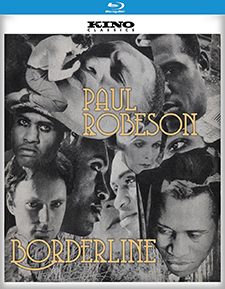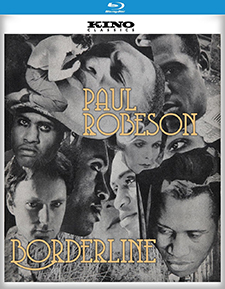Borderline (1930) (Blu-ray Review)

Director
Kenneth MacphersonRelease Date(s)
1930 (April 22, 2025)Studio(s)
Pool Films (Kino Classics)- Film/Program Grade: C+
- Video Grade: C+
- Audio Grade: A
- Extras Grade: B
Review
Paul Robeson is best known for his roles in the films The Emperor Jones (1933), Show Boat (1936), and King Solomon’s Mines (1937). An actor and singer, he was a commanding presence on screen, but his career stalled at its peak when he was blacklisted because of his outspoken views on U.S. government policies. Borderline, produced by a British film company and shot in Switzerland, stars Robeson in a silent film made three years after the introduction of sound to motion pictures.
When Black couple Pete (Robeson) and Adah (Eslanda Robeson) rent a room above a tavern in a Swiss village, their presence brings out fears and biases as well as jealousies among the townspeople. Adah has an affair with a married white man, Thorne (Gavin Arthur), further riling up anger and racism in the small community. Thorne’s wife, Astrid (Helga Doorn), is overwhelmed by being rejected for a Black woman. Consumed with feelings of inadequacy and shame, she spews ugly racist views blaming her plight on the presence of Blacks in the country.
Thorne is unsympathetic and clueless. He never accepts responsibility for the affair, and maintains that his relationship with Adah goes beyond lust. Benefiting from social advantages denied to Pete and Adah, he remains accepted by the community while the townspeople reserve blame for the Black couple.
As emphasis shifts to other characters, Robeson’s Pete disappears from the film for a long time, returning for the climactic scenes. When we see him—often in close-up—his face reveals disappointment, anger, helplessness, and sorrow. He’s in despair over his wife’s infidelity but held in check—at least initially—by white society’s unspoken rule that Blacks know their place. It’s a shame Robeson didn’t have more of an active role. His Pete comes off weak, almost frozen in his inability to take charge of a bad situation.
In its third act, the film becomes operatic in its resolution, raising what was an interracial affair into much more. When pent-up passions are finally released, there are many who suffer.
The best silent films let visuals tell the story and keep intertitles to a minimum. In Borderline, however, director Kenneth Macpherson uses too few intertitles, leading to confusion for parts of the film. Where titles do appear, they’re whisked off screen before the viewer has time to read them. While lacking in coherence, the film is so overstuffed with symbolism—lingering shots of hands, knives, mountains, streams—that they become tiresome and lose their impact. Macpherson also includes shots that don’t seem to move the narrative forward, leading to confusion. Why are we looking at those trees? Or those buildings?
The newly recorded score by Paul D. Miller, aka DJ Spooky, seems to be working against the visuals, either being too upbeat in sensitive scenes, too fast in suspenseful scenes, or too lacking in the film’s few action scenes. After a while, the soundtrack becomes insistently monotonous. It’s good music but mismatched to this particular film.
Borderline is far from Paul Robeson’s best screen work. Despite his top billing, the script gives him little to do and Macpherson’s lackluster direction treats him as an ensemble player rather than a star. Every so often, close-ups of his expressive face allow his larger-than-life personality to shine through, but his booming bass-baritone voice is missed and his screen presence, usually so impressive, suffers. If this is the only Paul Robeson film one sees, he will come off as disappointing.
Borderline was considered a lost film until it surfaced in Switzerland in 1983. Because of its frank treatment of race relations, the film could not have been made in Hollywood at the time since the Hays Office, the same year as the film’s 1930 release, expressly forbade U.S. filmmakers to depict romantic or sexual activity between people of different races. Shocking in its day, the film seems rather tame by today’s standards. The fact that it was made by a British company may explain its openness and ability to tackle tricky subject matter. Despite its shortcomings, it’s great to have this picture re-join the ranks of Robeson’s limited screen output. It’s a milestone in the treatment of interracial relationships in cinema.
Borderline was shot by the director, Kenneth Macpherson, on 35 mm black & white film with spherical lenses, finished photochemically, and presented in the aspect ratio of 1.33:1. The Blu-ray presentation was mastered from a 2K scan of 35 mm materials preserved by the George Eastman Museum. There are noticeable scratches, mostly on the far left and far right, throughout the film, but because of their location, they’re a minor distraction. At one point, a series of flash cuts is so quick that a strobe effect is created. Pace in general is fast, with quick cutting, close-up inserts, and montage, but the editing is often choppy. Odd shadows on Robeson’s face give him an ominous look. Director Macpherson combines subjective and objective camera as the story unfolds. Avant-garde filming techniques, many ahead of their time, include the use of montage, popularized by Sergei Eisenstein, and a psychoanalytical way of illustrating the characters’ emotional and psychological states.
The soundtrack, a 2.0 DTS-HD Master Audio track, would be nice to listen to on its own. As accompaniment to Borderline, however, it doesn’t work. Perhaps that’s because it’s too good, often taking the spotlight away from the film. Contemporary soundtracks written for silent films typically allow the film to dominate. Here, instead of complementing and clarifying the action, this insistent track draws attention to itself, which is especially unfortunate in a silent film that’s nearly devoid of intertitles. That being said, the jazz-infused music sounds rich, with excellent clarity. It would have been nice to have both the new score as well as the original, if it were available.
The only bonus material on the Blu-ray release from Kino Classics is an audio commentary by film historian Anthony Slide, who refers to Borderline as “not your average film.” It’s about a group of people thumbing their noses at society. The film is “very much of its period,” even quaint by today’s standards. An early English film magazine called Close-Up was opposed to censorship, particularly the British Board of Censors. Its critics were also opposed to the advent of sound, which they referred to as a “monstrosity.” That accounts for why Borderline was made as a silent film when the industry had long transitioned to sound. The melodramatics of scenes speak for themselves. Shooting a silent film kept costs down. Slide provides background on the entire cast, with emphasis on Paul Robeson, the film’s star. Both Robeson and his wife, Eslanda, had leftist leanings and he was blacklisted for years for his political beliefs. Eslanda was the architect of his singing and acting career. Even though he’s off screen a lot in Borderline, when he appears, he’s dominant. Robeson is best remembered for Show Boat. He played the character of Joe and sang Ol’ Man River in a 1932 Broadway revival of the musical and in the 1936 film. In 1943, he starred on Broadway in Othello. Robeson is often filmed in close-up from a low angle, giving him the appearance of an icon. In Borderline, he conveys “exotic decadence and sexuality.” The film is open to many interpretations. Some shots go on too long and seem ill-conceived since they don’t suggest why they’re included. Director Kenneth Macpherson is “overlong with trees and shrubs.” Paul and Eslanda Robeson worked only one week on the film. In terms of theme, Borderline points out that while some people (the residents of the Swiss village) live a free life, others, like Pete and Adah, struggle on the edge of what society demands of them. In conclusion, Slide notes that “Borderline is a well-meaning mess”—imperfect, but dealing with serious topics.
Borderline is interesting from a historical perspective and for Paul Robeson’s appearance. It hasn’t aged as well as other silent films but does reflect some interesting directorial choices. Uneven, often muddled, and burdened with heavy symbolism, the film deals with a taboo subject, something American films at the time shied away from.
- Dennis Seuling

